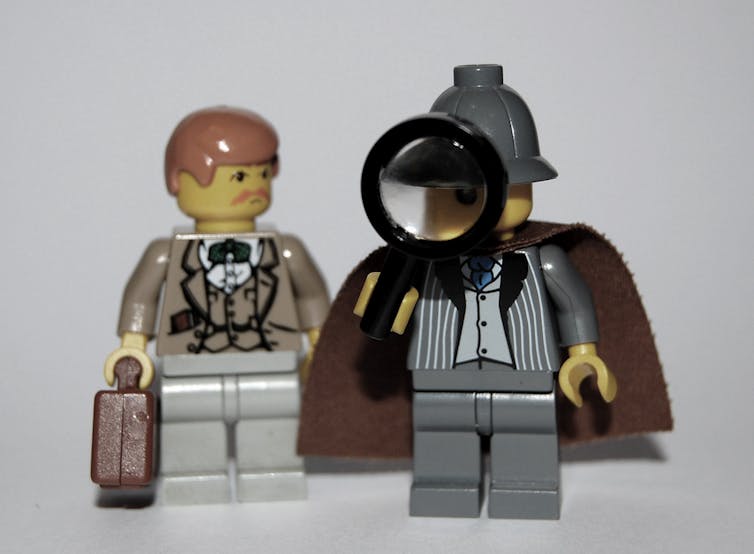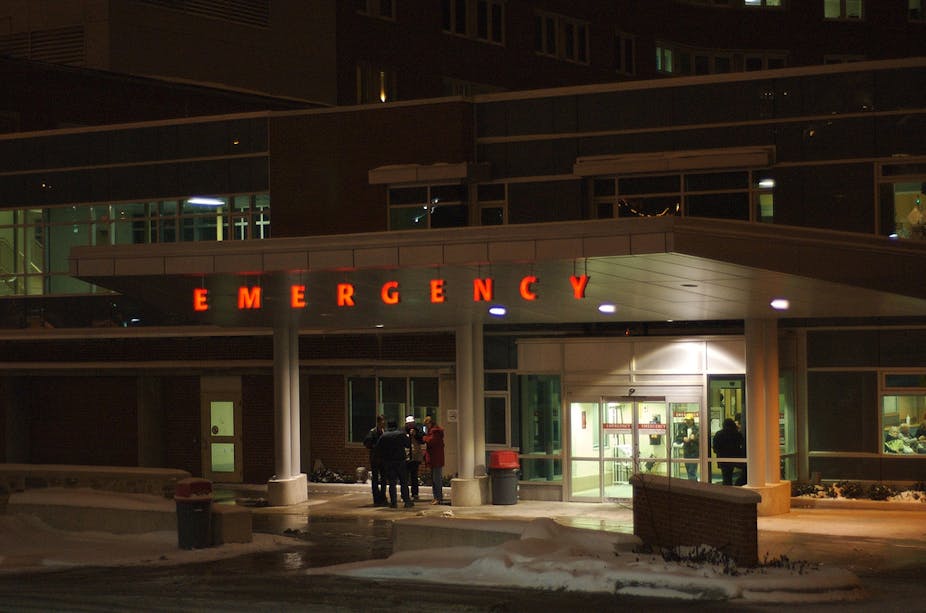Walking into each room to greet my next patient often reminds me of Forrest Gump: “You never know what you’re going to get.” It’s challenging to have only one chance to get it right but I love being an Emergency Room doctor.
Today, an older lady has slipped at home and she’s taped to a hard backboard with a rigid neck collar in place. It’s routine for all patients involved in car accidents or falls or anything that could cause a spinal cord injury. When I see her, her head is bandaged with gauze stained with blood. While medical staff attach her to a cardiac monitor and blood pressure machine, the paramedic relays her medical history to anyone who will listen.
My head makes a subconscious examination of the patient and the room. It feels a bit like being in BBC series Sherlock, where small icons pop up on the screen detailing the detective’s thoughts, observations, and deductions; white female, age 60ish (higher risk of intracranial bleeding, probably needing CT scan of head) moving fingers and toes (doubt spinal cord injury), talking to nurse (higher cognitive function intact), open eyes looking around the room (unlikely lens dislocation, oculomotor centre functioning normally). Within seconds, I know the chance of a devastating bleed in the brain or spinal cord injury is extremely low.

Training my mind to process the subtleties of the human body didn’t happen after four years of medical school, but with years of repetition and thousands of patients. Some puzzles are more routine and easier to meld observations, questions and decisions into a diagnosis while others cases are confusing and unexpected - and much more demanding.
As I’m talking I realise that I spend a lot of time conversing with patients in unusual positions: upside down, talking to their backs, or during an invasive pelvic or rectal exam. But it’s all very matter-of-fact - like an art appraiser or a farmer inspecting sheep. We’re more hands on than other doctors - we often don’t have the luxury of knowing the patents beforehand or have information of previous examinations.
I feel the right side of my patient’s face and note the significant swelling. When I remove the bloody bandage to inspect it, blood spurts onto the floor, just missing my nurse. She’s not too pleased. All the while I ask her questions about how she fell, where she lost consciousness, and whether she walked around afterwards.
Interestingly, there are studies into how long different medical specialities wait before interrupting their patients. On average it’s between 18-23 seconds; for emergency doctors it can be less than ten. I don’t want to be rude so I’ll often let patients talk for a while before cutting them off - but the reality is I just want the facts.
An increasing number of visits to hospitals in the US each year overwhelms staff in most ERs on a weekly basis. Pair this with demands for improved documentation and an ever-present force pushing us to go faster and the patient-doctor dynamic changes. Instead of having a conversation with patients, I rapidly spew questions for terse answers in the least amount of time possible to get the vital information I need. Much as I love hearing stories, the information patients often want to share isn’t always what I need.
But amid these short interactions, where I’m held to the standard of not missing a life-threatening condition, I also have two other important goals: show empathy and make a personal connection.
My patient tells me she tripped and fell and hit her head against a dresser before phoning a friend for help. But she let the dog out first. As we laugh over her priorities, I suture her squirting wound. Connecting with patients is necessary. Despite all advances in medical practice, every patient has a mortality of 100%. I can’t prevent death. Delay it maybe, heal an acute injury, hopefully, but I can always alleviate suffering. And relating to patients as human beings, not just diagnoses, helps to do this.
Personal connections also help us empathise. We’re privy to the pain, struggles, challenges, heartaches, joys and relief our patients’ experience. But while emotional investment can be positive fuel, negative and disturbing stories drain internal emotional reserves; drug abuse, homelessness, mental health disorders, and the rapidly failing bodies of elderly patients comprise more than half of my patients. I relate to patients while in the room but as soon as I walk away I shed this bond.
It’s a survival mechanism, nothing more: keeping their burden on my shoulders would weigh me down and interfere with my ability to care for future patients.
I see my own mortality in each patient encounter. Luckily, today it’s good news and the accident could have been worse. Her head, neck, arm and leg aren’t broken and her forehead will heal. It’s nice to meet her and she thanks me for making her feel comfortable. But it’s time to shed another relationship.
I’ve got 20 patients to care for at the same time. By the time I return to my desk, everyone wants my attention: nurses with medication dosing questions, technicians with ECGs to review, medical students waiting to present their patients … all while my phone is ringing - a clinic wants to transfer a patient to me.

A pace this rapid may drive some physicians to early retirement, yet for me the challenge is becoming a multitasking Jedi. It forces me to be mindful of the happenings of the entire 60-bed department. Sometimes I’m in total control, other days I realise I haven’t eaten or used the bathroom for over eight hours.
Pressure in chaos keeps me on my game especially in such a humbling environment. Just when you think you have the patient relationship, the medicine, the patient flow down, something brings you back down to earth. A bad outcome or an inexplicable tongue-lashing from a patient alters your day and future practice for an unknown period of time.
But it makes me love my job even more. The diagnostic puzzles and ability to give care to people in times of need is a special combination that outside of my family gives my life a higher purpose. To practice medicine in an environment that expects 100% accuracy can be tough but it’s my calling.

